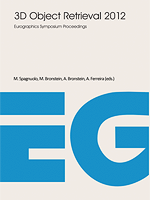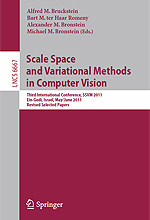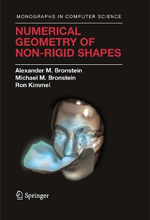| |||||||||||||||||||

|
M. Spagnuolo, M. M. Bronstein, A. M. Bronstein, A. Ferreira (Eds.),
Eurographics Workshop on 3D Object Retrieval, Eurographics Association, 2012. ISBN: 978-3-905674-36-1. Abstract: This book contains the research work presented at fifth Eurographics Workshop on 3D Object Retrieval (3DOR) held in Cagliari, Italy on May 13, 2012. The 3DOR workshop series was started in Crete (2008), and then held in Munich (2009), Norrkoping (2010) and Llandudno (2011), always as a co-event of the Annual Conference of the European Association for Computer Graphics (Eurographics). All five such workshops are successful examples of international cooperation and the attendance demonstrates the relevance of focused topics. Demonstrating the increasing importance of the workshop, a record number of 23 papers were submitted this year. These papers were reviewed by an international Program Committee of 35 external experts in the area. Based on their recommendations, a selection of nine long papers was accepted for presentation at the workshop, giving an acceptance rate below 40%. Additionally, six poster presentations describing timely research results of high quality were included in the workshop program. Similarly to the previous editions of the 3DOR workshop, this year's event hosted the seventh Shape Retrieval Contest (SHREC'12). The goal of the contest is to evaluate the effectiveness of 3D-shape retrieval algorithms, thus playing an important role in the evolution of 3D Object Retrieval research. SHREC'12 contributes to the proceedings with four additional papers that detail the results of the competition. We are grateful to the Eurographics association for their support, and to all reviewers for ensuring a high quality program despite the tight schedule. Special thanks are also to Stefanie Behnke for her constant and timely attention. Finally, we hope that this workshop proves useful to all participants and sets the ground for long term interaction, collaboration and identification of future directions and potential problems in the field. |
||||||||||||||||||

|
B. M. Bruckstein, B. ter haar Romeny, A. M. Bronstein, M. M. Bronstein (Eds.),
Scale Space and Variational Methods in Computer Vision, Lecture Notes in Computer Science (LNCS) No. 6667, Springer, 2012. ISBN: 978-3-642-24784-2. Abstract: The International Conference on Scale Space and Variational Methods in Computer Vision (SSVM 2011) is the third issue of the conference born in 2007 as the joint edition of the Scale-Space Conferences (since 1997, Utrecht) and the Workshop on Variational, Geometric, and Level set Methods (VLSM) that first took place in Vancouver in 2001. Previous issues in Ischia, Italy (2007) and Voss, Norway (2009) were very successful, materializing the hope of the first SSVM organizers, Prof. Sgallari, Murli and Paragios, that the conference would 'become a reference in the domain'. This year, SSVM was held in Kibbutz Ein-Gedi, Israel - a unique place on the shores of the Dead Sea, the global minimum on earth. Despite its small size, Israel plays an important role on the worldwide scientific arena, and in particular in the fields on computer vision and image processing. Following the tradition of the previous SSVM conferences, we invited outstanding scientists to give keynote presentations. This year, it was our pleasure to welcome Prof. Haim Brezis (Université Pierre et Marie Curie, France), Dr. Remco Duits, (Eindhoven University, The Netherlands), Prof. Stèphane Mallat (École Polytechnique, France), and Prof. Joachim Weickert (Saarland University, Germany). Additionally, we had six review lectures on topics of broad interest, given by experts in the field, Profs. Philip Rosenau (Tel Aviv University, Israel), Jing Yuan (University of Western Ontario, Canada), Patrizio Frosini (University of Bologna, Italy), Radu Horaud (INRIA, France), Gérard Medioni (University of Southern California, USA), and Elisabetta Carlini (La Sapienza, Italy). Out of 78 submitted papers, 24 were selected to be presented orally and 44 as posters. Over 100 people attended the conference, representing countries from all over the world, including Austria, China, France, Germany, Hong-Kong, Israel, Italy, Japan, Korea, the Netherlands, Norway, Singapore, Slovakia, Switzerland, Turkey, and USA. We would like to thank the authors for their contributions, the members of the Program Committee for their dedication and timely review process, and to Yana Katz and Boris Princ for local arrangements and organization without which this conference would not be possible. Finally, our special thanks to the Technion Department of Computer Science, HP Laboratories Israel, Haifa, Rafael Ltd., Israel, BBK Technologies Ltd., Israel, and the European Community's FP7 ERC/FIRST programs for their generous sponsorship. |
||||||||||||||||||

|
A. M. Bronstein, M. M. Bronstein, R. Kimmel,
Numerical geometry of non-rigid shapes, Springer, 2008. ISBN: 978-0-387-73300-5. Abstract: Deformable objects are ubiquitous in the world surrounding us, on all levels from micro to macro. The need to study such shapes and model their behavior arises in a wide spectrum of applications, ranging from medicine to security. In recent years, non-rigid shapes have attracted a growing interest, which has led to rapid development of the field, where state-of-the-art results from very different sciences - theoretical and numerical geometry, optimization, linear algebra, graph theory, machine learning and computer graphics, to mention a few - are applied to find solutions. Numerical geometry of non-rigid shapes is the first attempt to consistently present nonrigid shape analysis, bringing together a variety of problems and approaches. The book gives an up-to-date overview of current state of science in the field. Self-contained presentation of topics unfolds systematically and numerous figures enrich the engaging exposition. Everyday examples are used to explain concepts and to illustrate different techniques. Practice problems follow the end of each chapter, with detailed solutions to selected problems in the appendix. The book will be of interest to graduate students, researchers and professionals in different fields of mathematics, computer science and engineering. It could be used for courses in computer vision, numerical geometry and geometric modeling and computer graphics or for self-study. Book website | Code | Tutorials | Data | Slides | Annotated bibliography |
||||||||||||||||||
|
| |||||||||||||||||||